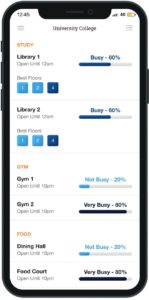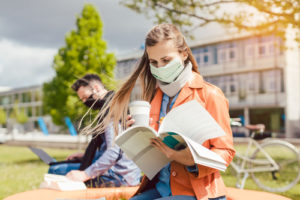A growing number of universities and Fortune 1000 companies are relying on innovative crowd monitoring technology from Occuspace, an IoT occupancy data solution provider, to help contain the spread of COVID-19 and protect students and retail customers. Schools including Baylor University, University of Rochester, Oklahoma University, multiple University of California campuses and many others are empowering their campus communities to “know before they go” into a crowded building to promote a safer and more convenient on-campus experience.
Baylor University, University of Rochester and more using new Occuspace tech to help contain the spread of COVID-19.

The pandemic has propelled the rapid adoption of new technologies at higher education institutions including online learning platforms, contact tracing and heat mapping in order to control clusters and virus spread. Yet, what can be densely populated spaces like libraries and dining halls do not have to remain off-limits for students. In fact, many universities are touting the benefits of cost-effective crowd monitoring technology that lets individuals make educated decisions about where they go and for building staff to ensure spaces stay within their safe capacity limits. Recently, Baylor University implemented occupancy monitoring as part of the school’s COVID-19 response.
“As the university was preparing for fall, we realized this was a tool that could help us keep our numerous study spaces in our libraries open safely during the pandemic and provide a valuable service to students,” said David Burns, associate vice president of library and academic technology services at Baylor. “It’s a convenient safety feature for our students given the times we are living in and an extra precaution that Baylor is offering.”
Occuspace works by plugging sensors into wall outlets that scan for Wi-Fi and Bluetooth activity from laptops, cell phones, wearables and other connected devices without storing any personally identifiable information or requiring large infrastructure changes. The data shows the crowd levels of spaces like gyms, dining halls and classrooms at any given time with over 90% accuracy. Occupancy information is displayed via the company’s free mobile app, Waitz, as well as in school provided monitors placed in the entrances to buildings and/or dedicated university web pages.
Reducing costs and improving the student experience are major factors influencing how universities respond to the pandemic on their campuses. When it came to implementing new technology that meets budget requirements, the Dean of Libraries at Baylor University, Jeffry Archer, adds, “Occuspace is part of Baylor’s COVID-19 response expenses and was a relatively minor cost compared to other precautions taken by the university.”
As officials at the University of Rochester began evaluating how to de-densify student spaces on campus, they knew that moving a few chairs or desks wouldn’t do the trick for social distancing. They adopted Occuspace before the start of the school year to analyze space usage trends and proactively respond to potential crowding.
“Long before the coronavirus outbreak, staff at our River Campus Libraries have desired to get a better sense of how many students are using the spaces at any given time,” said Lauren Di Monte, associate dean, learning, research and digital strategies at the University of Rochester. “Each day’s data provides a chance to evaluate how spaces are being used and how they could be modified to make them safer or more accommodating during this precarious time.”
To view how the technology is being used at the University of Rochester, watch this two-minute ABC news story.
The school’s administration also benefits from seeing in real-time when occupancy levels in monitored spaces on campus are close to exceeding capacity. For them, the sensors provide the ability to look at a broader swath of foot traffic data to inform long-term and strategic plans for buildings when it comes to facilities management and energy efficiency.
The Occuspace technology was created by UC San Diego alumni Nic Halverson, Linus Grasel and Max Topolsky. It officially entered the market in 2018 and has seen significant growth from universities and businesses, such as restaurants, gyms, ski resorts and apartment communities, since the start of the year.
“Before COVID, our technology was intended to help remove the element of surprise and frustration people felt when they headed out to a potentially crowded place,” said Halverson, CEO and co-founder of Occuspace. “The pandemic has changed people’s comfort levels for proximity. We quickly realized the value our live crowd data could play in helping businesses stay open and promote social distancing while allowing visitors to feel more secure about the spaces they are planning to enter.”
To date, Occuspace is helping to keep over 450,000 students safer and socially-distanced at a growing number of college campuses across the U.S. and Canada. To learn more about Occuspace and how it works, visit occuspace.io.
About Occuspace
Occuspace is changing the way universities and retailers approach monitoring occupancy to promote safe social distancing. The company’s real-time people counting sensory hardware and corresponding iOS and Android application, Waitz, help users monitor population density of a given space and can alert building staff when a space is approaching its safe capacity limit. Helping to rebuild trust through transparency, especially during a worldwide pandemic, Occuspace allows visitors to know when occupancy at an establishment is at the right comfort level for them. For more information, visit occuspace.io.
- Extron AV Switching, Streaming, and Control Systems Aid Higher Learning at Idaho’s First Medical School - June 1, 2021
- Extron XTP, Streaming, and Control Systems Empower Point Park University’s Varsity Esports Program - June 1, 2021
- Extron NAV Series Delivers AVoIP Throughout Allied Health Veterans Hall at UNC Wilmington - June 1, 2021

